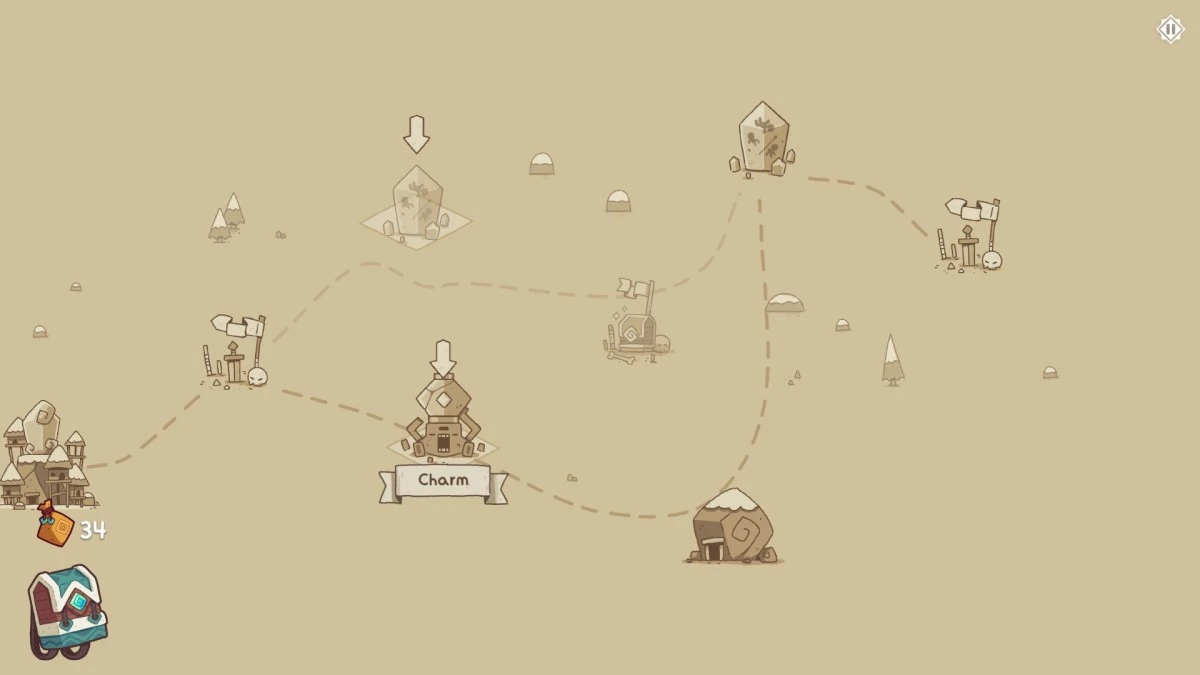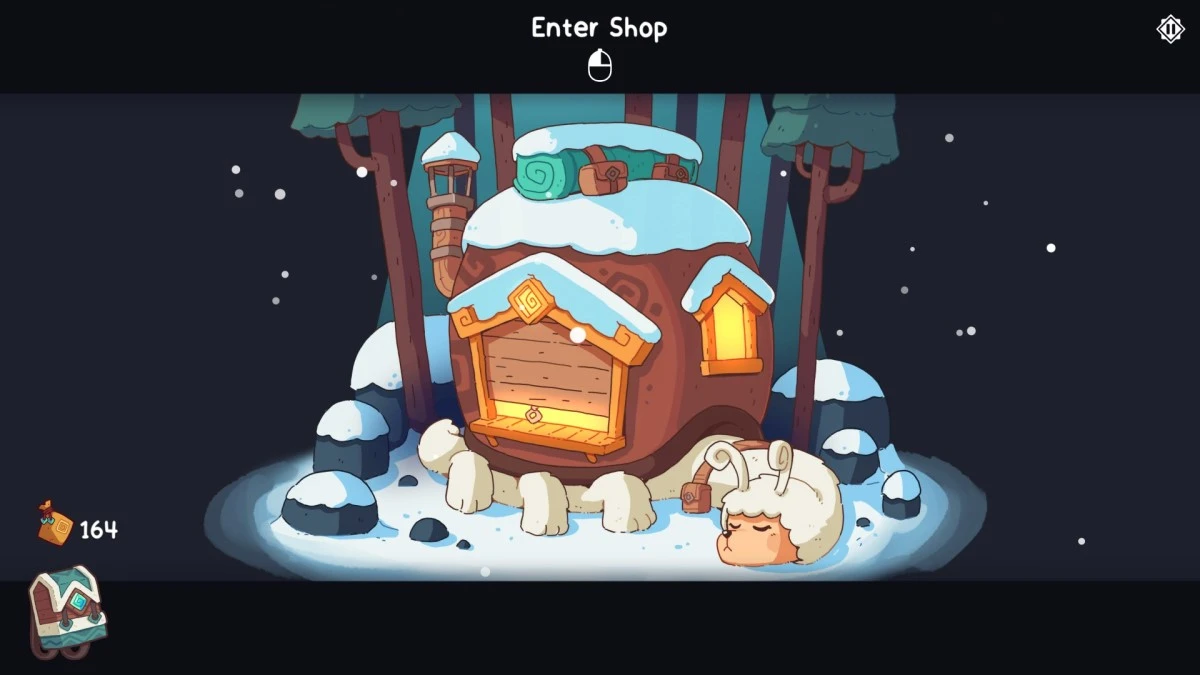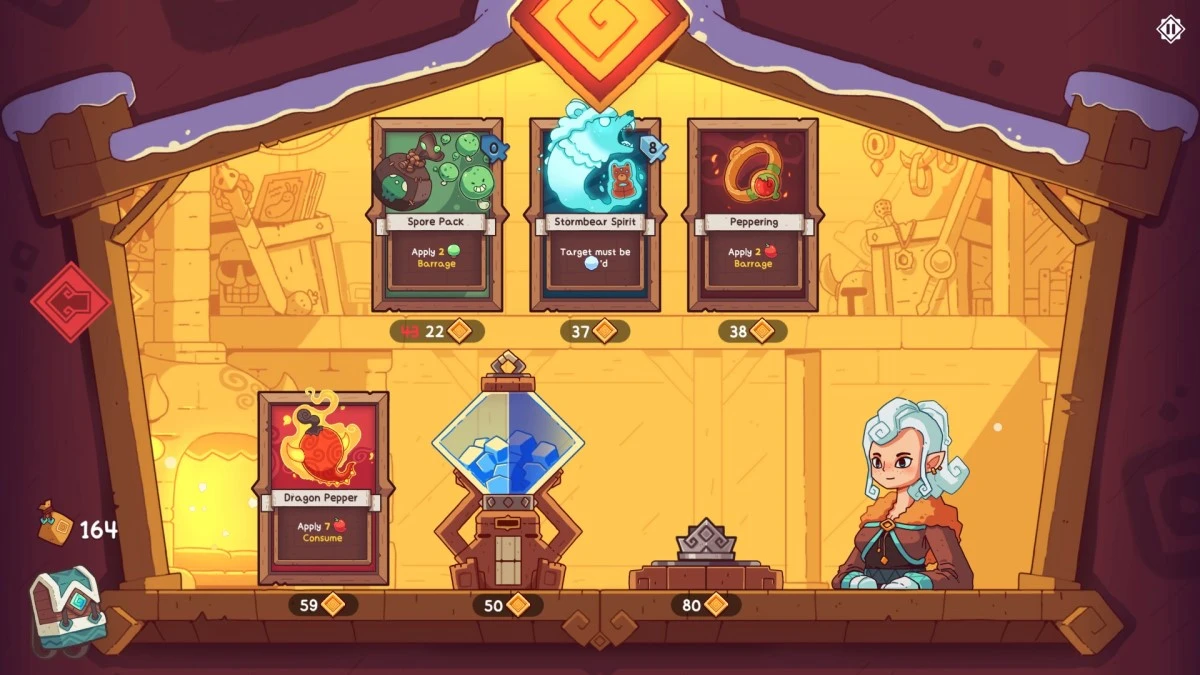Wildfrost is a game built on a contradiction. Its bright, warm visuals draw you in, but once you cross the threshold you’ll find that the game proper is an exercise in cold mathematics; a school classroom on a crisp winter morning. The game balances these dual identities, lovable cartoon romp and hard-edged turn-based tactics title, admirably throughout, but may leave you wanting for a more coherent blending of the two as things progress.
Saturday best
Wildfrost is the latest member of the in-vogue roguelike sub-genre, deckbuilder: an expanding niche popularized, and still largely defined by, 2019’s Slay the Spire. It owes a sizable debt to Mega Crit’s masterpiece, as we’ll cover shortly, but one thing it does indisputably better is visuals. Where Spire’s art style was functional at best, Wildfrost’s is an absolute show-stealer. Everything, from the tiniest tutorial prompt to the biggest boss battle, is rendered in the rich colors of a high-budget cartoon. Enemies pack a lovable ‘mwa-ha-ha’ menace, while the companion characters you pick up along the way are all so well-designed you’ll swear you saw them headlining your last Saturday morning in front of the TV.
- Screenshots by PC Invasion
Every new card you add to your deck, every new monster you encounter, is a treat for the eyes, creating a compelling reason to keep playing even if deckbuilders aren’t your cup of cocoa. It’s a game where simply browsing the menu and looking at the cards you’ve seen so far is a pleasure in itself. All of this to say: the art in Wildfrost is fantastic, which makes it all the more surprising that the game doesn’t lean further into this aspect when it comes to its narrative.
What’s the story?
You’ll notice this right from the start of the game. Once you hit play, you’ll be unceremoniously brought to the first major choice of each run: which Leader to go with? With no fanfare, and little explanation beyond some elementary tutorials doled out by a sun-faced sprite, Wildfrost gets stuck into business-as-usual much quicker than you’d expect. Based on the lavish visuals put forth in the game’s marketing efforts, I was expecting a storybook setup as lovingly crafted as everything else. A few pages of such a setup exist, picked up periodically as you advance and try out new Tribes, but other than that there’s little to draw you on but the vague task of reigniting the world’s lost sun: a quest which, based on the bright visuals and joyful tone throughout, hardly feels urgent or necessary.
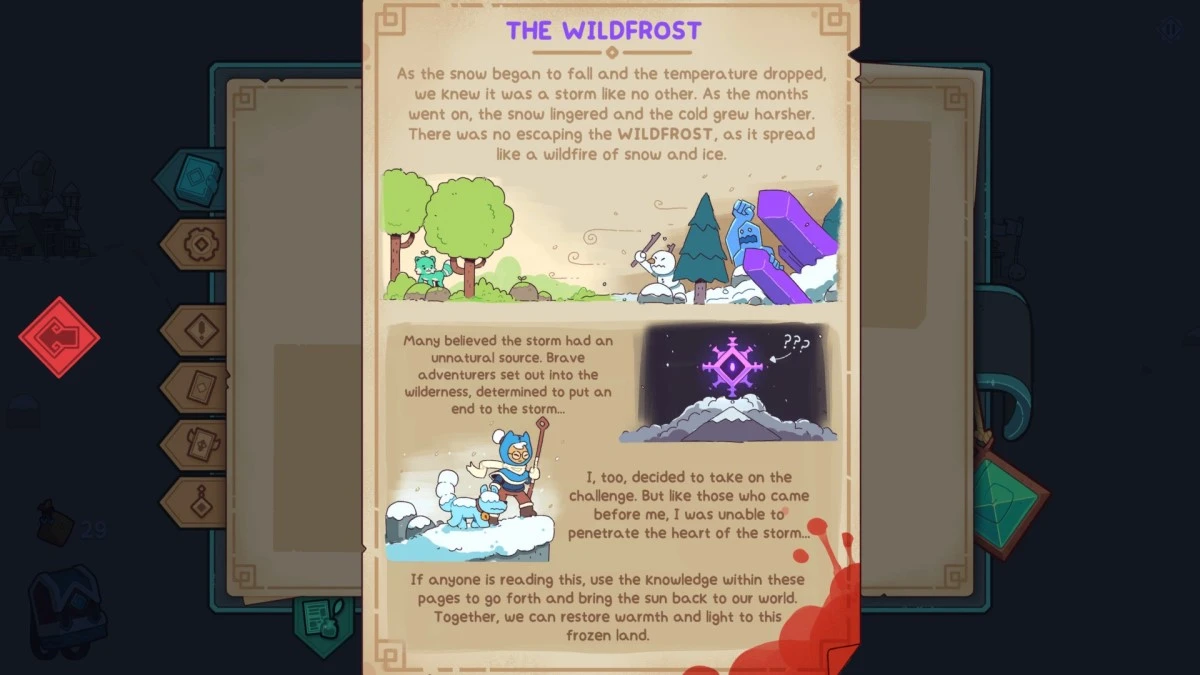
Screenshot by PC Invasion
Of course, a compelling narrative isn’t the first thing most people think of when they think of deckbuilders, and the absence of one here doesn’t ruin the game, even if it feels more conspicuous than usual. The real meat of the experience is the gameplay, and it’s here that Wildfrost’s cheery, hand-painted mask slips, revealing a glimpse of the cruel, snarling beast beneath. For you see, when it comes to combat, Wildfrost isn’t messing about.
Written in the cards
Battles play out like a surprisingly effective mix of Slay the Spire and Hearthstone, particularly the latter’s auto-chess-esque Battlegrounds mode. You begin by placing your chosen Leader on the battlefield, before drawing a selection of cards from your deck to support them. These cards vary from simple effects such as stat buffs and damaging attacks, to fully-fledged Companions you can deploy to protect your Leader. This is important, as once your Leader dies it’s game over, regardless of how many loyal followers you have waiting around to take up their mantle.

Screenshot by PC Invasion
Each character you have in play, and each enemy they face, acts on a timer that counts down every turn. This means that, in a more drawn-out version of Slay the Spire’s enemy attack telegraphs, you’ll always know what’s coming next, and you’ll always have time to prepare a counter to it. This may involve freezing an enemy to delay a powerful attack just long enough for you to finish them off, or repositioning your forces to keep your Leader alive when stopping an attack is impossible. It’s a system that gives you a huge amount of agency over how encounters play out, and it combines with a near-total lack of mechanical randomness to create battles that run like elegant clockwork dances rather than chaotic brawls.
As the philosophers warned, however, this perfect knowledge is a double-edged sword. On one hand it allows for you to plan your strategy many moves in advance, and feel the satisfaction when your counters hit zero simultaneously and your perfectly-choreographed assault plays out in thrilling sequence. On the other hand, it can lead to situations where you see your defeat coming many turns in advance, turning the game from a cheery cartoon adventure to a brief stint on death row as you desperately scramble for the trump card you know for a fact isn’t coming. You’ll sigh, you’ll be tempted to quit the run out of spite rather than watch your own slow-mo death animation, then you’ll end your turn and watch the inevitable unfold. Moments like this can be deflating, especially when they come at the hands of the once-per-battle bosses and minibosses Wildfrost is so fond of, and it doesn’t help that they’re often not entirely your fault.
Keeping it together
Because Wildfrost, like Slay the Spire and the many interim imitators since, hasn’t quite solved the problem of inconsistency across runs that plagues not just deckbuilders but roguelikes in general. Like most such titles, Wildfrost features a range of roughly-defined archetypes: a Snow build, a Shroom build, a self-sacrifice build, so on and so forth. The best path to success lies in picking one of these archetypes and sticking with it, grabbing as many cards that compliment it as possible to maximize the synergy your deck offers. The problem is that the cards you’re dealt are random, meaning in many runs what you’ll end up with is not a coherent deck but a disjointed stack with little going for it.

Screenshot by PC Invasion
The idea, in theory at least, is that you should be able to leverage such ragtag piles of cards into a victory with your wits and wiles alone, but that simply doesn’t pan out in reality. The runs where you succeed are the ones where your cards match well, the runs where you fail are the ones where they match poorly, and there’s little you can do to influence the outcome outside of optimizing your performance in combat: something which, in a turn-based game like this, has a much lower ceiling than in real-time titles like Dead Cells or Risk of Rain. It’s not a problem exclusive to Wildfrost, and it’s certainly not one we’d expect a game to single-handedly solve, but it’s worth noting as a potential pain point regardless.
The Breakthrough
Beyond the snow-dusted fields of battle, Wildfrost lets you build both infrastructure and rapport in the fledgling settlement of Snowdwell. As you complete challenges out in the field new buildings and characters will be unlocked, each providing a valuable service and expanding your options in future runs. These advancements are a nice carrot for Wildfrost to dangle in front of you, ensuring that some progress is possible even on a disastrous run, but they often feel underwhelming as rewards, eschewing the all-but-inevitable victories promised by the advancement systems of Loop Hero and Rogue Legacy in favor of new cards with corner-case gameplay applications. This means that there’s no secret snow plow to unlock that will let you cruise to the end of Wildfrost: you’ll need to pick up that battered old shovel and get to work.
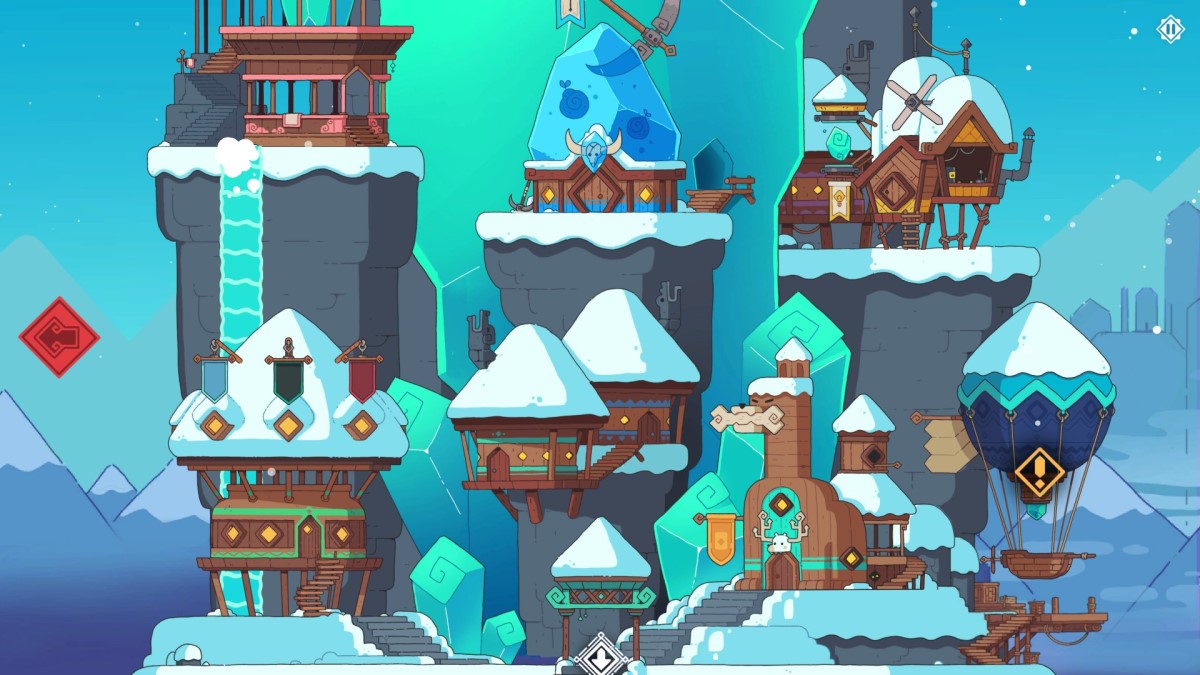
Screenshot by PC Invasion
For a roguelike, that’s no bad thing. Victory in Wildfrost is hard-earned, and once you do finally crack the surface you’ll find that many surprises lurk in the icy waters below, pleasant and unpleasant in equal measure. And it’s here that we come full circle: all of this difficulty, this gradual, grinding progression, would struggle to sustain your attention were it not for the stunning facade that lured you in in the first place. Wildfrost is a coin with two distinct faces, ever spinning through the air, taking you on an emotional journey that spans laughter and loathing, agony and ecstasy, often in the course of a single battle. How the coin lands will determine your success in Wildfrost, but it’s the light catching on both sides while it’s in flight that will, ultimately, determine your enjoyment of it.

